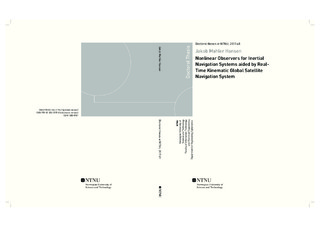| dc.description.abstract | This thesis is motivated by recent interest in nonlinear observers for navigation. The field of navigation is dominated by the Kalman filter and its variants. However, nonlinear observers offer some advantages, compared to the Kalman filters, which will be highlighted in the thesis.
Nonlinear observers for navigation estimating the position, linear velocity and attitude of a vehicle is of interest. The navigation solutions presented in the following are vehicle independent and can be used for ground, surface and air vehicles, or any moving body in general. However, for the experimental verifications small aircraft will be used as they have fast dynamics and can be seen as worst-case scenarios. The proposed observers will be benchmarked against state-of-the-art Kalman filters to ascertain performance and robustness.
The proposed navigation solutions use inertial measurements to propagate the navigation states, while global navigation satellite system (GNSS) measurements are used for correction of the states. The GNSS measurements will be considered in position as well as range space, allowing for loosely- and tightly-coupled integration. A modular structure is used for the nonlinear observers consisting of an attitude estimator and a translational motion observer (TMO). The attitude estimator represents the attitude as a unit quaternion ensuring resistance to singularities while allowing for semi-global exponential stability results of the observer structure. Global exponential stability results can be obtained by use of hybrid theory and switching. The TMO will be developed to accommodate loose or tight integration without altering the attitude estimator.
The main part of the thesis covers four variants of the nonlinear observer structure. Initially the loosely-coupled observer will be introduced and compared to an extended Kalman filter. Implementation issues, attitude reference vectors and observer gains are considered, while the performance comparison confirms that the nonlinear observer can be used instead of a state-of-the-art state estimator.
The second observer structure to be presented deals with the time delay introduced by the use of GNSS receivers. Due to the computational time and the dissemination time of the electronic signals of the receiver the GNSS measurements are delayed. A measuring approach for the delay is proposed based on timing using satellite time. Two versions of the loosely-coupled observer structure are proposed where the inertial measurements are delayed to correspond with the GNSS measurements, followed by fast simulation for propagating the estimates to current time. Experimental data confirms a significant performance impact compared to uncompensated systems.
The third observer structure introduces a tightly-coupled structure where aiding range and range-rate measurements are utilized. The receiver clock bias is included as a slowly time-varying state. Semi-global exponential stability is achieved by use of nonlinear injection terms. The only linearization takes place when determining the TMO gains by solving a slowly time-varying Riccati equation. Experimental verification confirms the performance to be comparable with the performance of a multiplicative extended Kalman filter. Furthermore, the computational load of the observer is seen to significantly lower the number of operations compared to the state-of-the-art estimator, allowing for implementation on smaller and cheaper platforms.
The fourth observer structure introduces an additional GNSS receiver to be used as a reference base station. The inertial navigation is aided by double-differenced pseudorange, carrier-phase and carrier phase derived Doppler measurements between the two receivers thereby cancelling dominating environmental disturbances. A real-time-kinematic (RTK) solution is thereby formed ensuring high accuracy. Using experimental data the observer using double-differenced GNSS measurements is confirmed to obtain centimetre level accuracy during a 20 minutes flight where high dynamic behaviour is experienced.
The advantages of nonlinear observers compared to Kalman filters cover; proven stability results, reduced need for linearization, and lower computational load, while ensuring high performance. A disadvantage is that the nonlinear observer does not propagate covariance estimates. | nb_NO |
